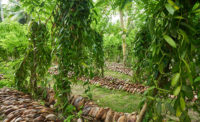Meet the experts
- Jessica Blondeel, product manager for chocolate, Puratos Corp., Cherry Hill, N.J.
- Alistair Davis, head of cocoa sustainability, Olam Cocoa, Singapore
- Seema Kedia, senior manager, marketing and sustainability, Barry Callebaut, Chicago
- Rick Stunek, marketing & sales, Forbes Chocolate, Broadview Heights, Ohio
- Taco Terheijden, director of cocoa sustainability, Cargill Cocoa & Chocolate, Wayzata, Minn.
According to the International Cocoa Organization (ICCO), roughly 72% of the world’s cocoa production occurs in West Africa, with Latin America accounting for another 18% and Asia and Oceana shoring up the remaining 10%. So for North American chocoholics, there really is no such thing as locally sourced chocolate.
North Americans will find, however, chocolate and cocoa that are both traceable and transparent. As Seema Kedia, senior manager, marketing and sustainability for Barry Callebaut, Chicago, explained, today’s consumers increasingly want visibility into the supply chains of the foods and beverages they consume.
“You see this across all categories, and cocoa is no exception,” Kedia said.
Cocoa and chocolate suppliers are listening, responding with sometimes detailed looks into how they source their wares. But tracing the long and winding road cacao takes en route to becoming chocolate or cocoa is tricky even for the pros. So we sat down with a few of them to learn about the logistics involved, and why a commitment to traceability is worth it in the end.
Dairy Foods: To start, what’s all this fuss over cacao traceability about?\
Jessica Blondeel: Our Taste Tomorrow global consumer research has shown that consumers want to know where their ingredients come from and who farmed them. This is relevant not only for chocolate, but for a wide array of products like produce or bread. But zooming in on chocolate, I think its supply chain has received a fair amount of negative press linked to child labor concerns, which is why consumers are paying even more attention to a “clean” supply chain.
Rick Stunek: It’s very important to a certain percentage of consumers. And the industry would love to do it because it makes sense for them in so many ways. But ultimately, it’s being pushed hardest by NGOs and other professional “agents of change” because their existence depends upon transforming emotion into dollars. Ultimately, it’ll have to be driven by the broad consumer market because they’ll have to pay more for it to happen.
Dairy Foods: That’s an interesting proposition — and one we’ll pick up on later. But before that, give us the rundown of how cacao becomes cocoa or chocolate.
Blondeel: The transformation of cacao into chocolate begins with a tree, Theobroma cacao. Grown in humid, tropical climates around the equator, it begins bearing fruit after about two years. Emerging directly from the trunk of the trees, each cacao pod contains 30 to 50 precious cacao beans, covered in a sweet and fruity white pulp. Harvested manually, both pulp and beans are removed from the pod to undergo a critical step of natural fermentation, either between banana leaves or in wooden boxes.
Kedia: The beans ferment for five to seven days. It’s during fermentation that the cocoa develops its initial flavor precursors. After fermentation, the beans are left to sun-dry for about six days until their moisture content is around 6 to 8%. Beans are then packed, graded and sold.
Blondeel: The journey continues as the beans are then shipped to chocolate producers, where they’re roasted, winnowed and ground into cocoa mass. This mass is then mixed with sugar and other ingredients and further refined and conched to develop the aromas loved by chocolate lovers everywhere.
Dairy Foods: Given this path, what does traceability mean vis-à-vis cacao and — subsequently — cocoa and chocolate?
Taco Terheijden: Traceability is being able to understand the product’s journey — or, as the World Cocoa Foundation defines it, “a methodology that provides the ability to identify the path and the history of a cocoa product and monitor the processes it is subjected to throughout the supply chain.”
From a sustainability perspective, traceability is about being able to see from where the cocoa was sourced and under what circumstances. Transparency is the goal, and supply-chain visibility and traceability are the tools to achieve it.
Dairy Foods: What processes, practices and parameters are we tracing, then?
Terheijden: We ensure that sustainable certified cocoa comes from farmers who participate in our programs. With the extensive data from our monitoring and evaluation system, we know under which circumstances it’s produced.
As far as quantifiable measures go, in Cote d’Ivoire alone, we work with more than 110 partner cooperatives. More than 80,000 smallholder farmers are registered in our monitoring and evaluation system, of which we have GPS-mapped over more than 50,000 farms.
We’ve gathered more detailed data than ever, including [information] about the location, size and footprint of each farm surveyed, the type and age of trees grown, the cultivation methods used, the choices made about fertilizers, replanting activities and the use — or not — of shade trees, plus a wealth of information about farming families and communities. Sharing this data with farmers and farm organizations allows them to better plan and target their activities to improve cocoa profitability.
Blondeel: Controlled separation of our certified Cacao-Trace cocoa from other cocoa beans throughout the supply chain — all the way from harvesting through to processing — guarantees the physical traceability of all Cacao-Trace cocoa. Since we tag every bag of dried Cacao-Trace beans, we’re able to trace it back to the farmer who sold it to us.
Dairy Foods: I want to touch on those money matters in a moment. But first, tell us how traceability pays off more broadly in these farming communities.
Terheijden: Traceability pays off in many ways. It encourages long-term improvements in productivity, quality and cost-efficiency, enabling farmers to form strong and long-term relationships with buyers. Farmers gain greater financial transparency — that is, insight and assurance into their premiums and the volume they can sell.
It also allows us to tailor our services to match their needs based on location, farm characteristics and size, while also helping these farmers’ communities at large. Through this, farmers and their communities benefit from training and coaching approaches, need-based community interventions, farm development and support in line with the strategies of public- and private-sector partners.
Blondeel: Cacao-Trace helps farmers improve their yield and rewards them with a premium for high-quality cocoa. Improving the quality of their cacao beans means that the more farmers earn, the more motivated they’ll be to continue growing better-quality cacao beans. And by earning more, farmers are able to invest in their farms, skills and families.
Dairy Foods: Well, explain how traceability literally puts money in farmers’ pockets — or onto their phones.
Blondeel: To improve profit sharing, Puratos developed the Chocolate Bonus. For every pound of Cacao-Trace certified chocolate we sell, 5 cents is paid back to the farmer. This simple and transparent payment system is unique in the market and ensures that 100% of the Chocolate Bonus reaches farmers through the Next Generation Cacao Foundation, the mission of which is to contribute to the social, economic and environmental development of cacao farmers and communities that are part of the Cacao-Trace program.
The Chocolate Bonus also generates an additional incentive to farmers to continue to grow high volumes of quality cacao. Today, Cacao-Trace farmers in Vietnam and Ivory Coast receive a Chocolate Bonus twice a year. Local needs determine how the Chocolate Bonus is used.
Projects are defined and carefully reevaluated every two years. For example, farmers in Vietnam received cash contributions distributed according to the volume of cacao beans they deliver. In Ivory Coast, the first project is to supply much-needed water filters.
Terheijden: In Ghana, the Cargill Kokoo Fie are dedicated warehouse facilities in each participating cocoa community where farmers deliver their beans. Their beans are digitally weighed in front of them and assigned a fully traceable bar code, and payment is made to farmers by electronic transfer straight to their phone or e-wallet. This is a revolutionary initiative, made possible by our partnerships with E-Zwich, MTM Mobile Money and Tigo Mobile Money.
Farmers have warmly welcomed this, as it provides added assurance and certainty, improves their ability to trade more effectively and eradicates all risks associated with cash payments.
Dairy Foods: How else is technology helping us trace the cacao chain more fairly, thoroughly and accurately?
Terheijden: New technologies are speeding up traceability and connecting traceability data with other global data sets, enabling us to identify issue hot spots and target our approach. For example, our investment in the Kokoo Fie means that all cocoa beans are recorded in a standardized management system before they’re collected by larger trucks that transfer them to central warehouses. Thanks to the bar-code system, each individual bag of Ghanaian cocoa beans can be traced to the individual farm. As a result, we’re creating a fully traceable supply chain down to the farmer level.
Kedia: Use of technology in tracing the cacao chain is critical. As an example, Barry Callebaut has engaged with SAP to launch an innovative cloud-based solution for cacao-bean traceability and better sustainability data management within our own supply chain. The software solution is called “Katchilè” — a word from the local Baoulè language in Côte d’Ivoire meaning “change” — by the Barry Callebaut team implementing it on the ground.
Katchilè combines desktop and mobile device access, allowing for use in the most remote locations. Information on farmers, their farms and their communities can be recorded digitally at every level of Barry Callebaut’s supply chain. Farmer registration, cacao buying and processing and transportation records enable the traceability of beans from the farmer to the warehouse.
Additionally, sustainability-related activity records allow for assessment of individual farmer and community needs and analysis, resulting in higher-quality and higher-impact support. Beyond the usual services, farmers now have improved access to seedlings, fertilizer and training that cater to their specific needs.
The system went live in June 2016 with the ambition to cover all cacao farmers participating in our sustainability activities in Côte d’Ivoire — currently about 65,000 farmers. In May 2017, it was expanded to be used in our sustainability and traceability efforts in our Indonesian supply chain as well.
Alistair Davis: One of our key advances in tackling industry challenges has been the development and expansion of the Olam Farmer Information System (OFIS) platform. OFIS is unique in that it provides access to previously invisible or difficult-to-record data, thereby benefitting all parties in the supply chain. Through an Android app that works offline and in some of the world’s most remote locations, digital access to all “first mile” transactions, including crop purchases, input distribution and financing, is now available. Smallholder farmers are empowered by OFIS to make data-driven decisions for their specific farm, which supports improved yields and incomes.
OFIS provides data visibility down to the single-farm level. This includes farm maps; 50-point farmer data profiles complete with social information such as the distance from the farm to infrastructure like schools, health centers and water; training logs; farm improvement plan progress; and transaction history. It also generates “hot spots” to inform the creation of sustainability action plans and supports end-to-end traceability from supplier to customer through product bag coding and enhanced communication with field staff. Already, more than 93,303 farmers with 244,165 hectares are covered worldwide.
Dairy Foods: It’s heartening to hear how these advances are helping the people who grow our cocoa. But how does traceability help our readers — that is, cocoa users?
Terheijden: Customers benefit from being able to ensure that the premiums they pay for a sustainably sourced product are being put to good use, and that their cocoa comes from a credible source. Traceability is key to building a thriving cocoa sector for generations to come.
Blondeel: A strict selection of high-quality cacao, combined with controlled fermentation and drying, ensures that consumers no longer have to make a tradeoff between taste and sustainability. This is because of the program’s intense focus on the post-harvest process and on other factors such as soil, climate and the genetic variety of the bean.
Dairy Foods: This all sounds well and good, but there must be challenges involved in achieving traceability, right?
Kedia: There are approximately 5 million cacao farmers worldwide, most of whom are farming on small plots of land. In addition, most of these farmers don’t belong to a cooperative or group selling structure. With this large a network of farmers as the basis for the cocoa supply chain, it would be very challenging to trace cocoa from all individually.
In addition, most chocolate and cocoa products are made from a blend of origins for consistency of flavor. Mixing cocoa from around the world into a single chocolate or cocoa product adds yet another layer of complexity to traceability for the supply chain.
Stunek: I see the main challenges as cost and oversight. The farther back you try to trace, the higher the cost will rise. And I would think that rise would be exponential, not linear.
Dairy Foods: Are higher costs inevitable?
Kedia: Increasing traceability in the cocoa supply chain does have costs, as it often requires investment in technological, infrastructural and human resources. What’s important is to find the level of traceability that best serves farmers’ needs, but that also gives the desired level of visibility to consumers. Finding this balance allows increased sustainability at the farm level but also, hopefully, speaks to consumers in such a way that they find added value and, therefore, may also be willing to pay more.
Dairy Foods: And the oversight piece, Rick?
Stunek: Even if consumers were willing to pay triple for chocolate products, traceability requires that farmers, governments and traders in developing countries aren’t trying to exploit the system. That’s not easy.
Corporations often take the hit from the media and NGOs when things don’t go well, but you have to consider that there’s no way to control the actions of individuals in places where the culture and economy are very different from our own. So if a company claims full traceability and then just one person is caught smuggling noncertified beans, consumers no longer have faith in the system and all that effort is wasted.
Dairy Foods: That’s worrisome. But isn’t traceability worth it purely on the basis of its contributions to sustainability?
Kedia: Cocoa supply chain traceability and sustainability are very much interdependent, to a certain point. Primarily, upstream traceability — between the farmer and first purchase point — is fundamental for measuring the impact of sustainability efforts. For example, the cocoa from farmers participating in activities of the Cocoa Horizons Foundation is traceable from the farmer to Barry Callebaut’s first purchase point.
This level of traceability ensures that Barry Callebaut has a good understanding of which farmers are receiving sustainability interventions from the Cocoa Horizons Foundation, and with this information we’re able to survey those farmers over time and measure the sustainability impact of the activities on an ongoing basis.
Stunek: I’ve often read that sustainability and traceability are interdependent. But I disagree. I think you can make cocoa sustainable without having micro-traceability. You just need to make sure the farmers are the beneficiaries of the pricing and buying systems in place.
Besides, in my opinion, sustainability is a much better overall goal. It’s not overly important where the beans come from, provided that we’re improving the lives of farmers and their families, taking care of the environment and treating everyone involved fairly. That resonates with consumers. That should resonate with anyone who wants the world to be a better place.






